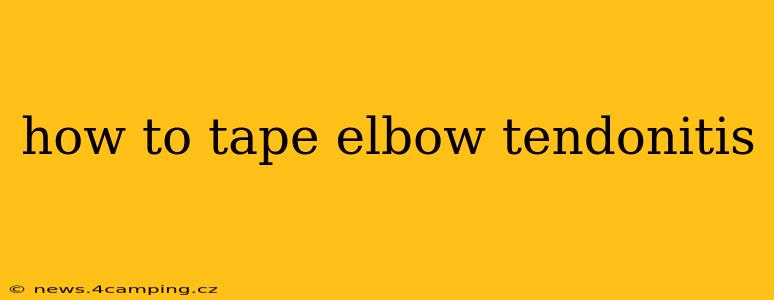Elbow tendonitis, encompassing conditions like golfer's elbow (medial epicondylitis) and tennis elbow (lateral epicondylitis), causes significant pain and discomfort. While medical advice should always be sought for diagnosis and treatment, taping techniques can offer temporary pain relief and support, improving your ability to manage daily activities. This guide explains how to effectively tape your elbow for tendonitis, addressing common questions and considerations.
Understanding the Benefits of Taping for Elbow Tendonitis
Taping for elbow tendonitis isn't a cure, but it can provide several benefits:
- Pain Reduction: Strategic taping can alleviate pain by reducing strain on the affected tendons and providing proprioceptive feedback (increased awareness of joint position).
- Improved Stability: The tape offers support, helping to stabilize the elbow joint and preventing further injury.
- Reduced Inflammation: By limiting movement, taping can indirectly help reduce inflammation around the affected area.
- Increased Range of Motion (potentially): In some cases, carefully applied taping can subtly improve range of motion by gently guiding the joint.
What Type of Tape Should I Use?
The best type of tape for elbow tendonitis is athletic tape or kinesiology tape. Athletic tape provides firm support, while kinesiology tape offers more flexibility and is designed to allow for a wider range of movement. Choose a tape that's appropriate for your activity level and comfort.
Step-by-Step Guide to Taping Your Elbow for Tendonitis (General Technique)
This general technique can be adapted for both medial (golfer's elbow) and lateral (tennis elbow) epicondylitis. Always consult with a physical therapist or athletic trainer for personalized guidance.
- Preparation: Cleanse the skin thoroughly to ensure the tape adheres properly. Hair removal might be necessary for optimal adhesion.
- Anchor: Start by placing an anchor strip of tape a few inches above or below the elbow joint, depending on the location of pain. This provides a base for the subsequent strips.
- Application: Apply the tape in overlapping strips, following the direction of the muscles and tendons. For lateral epicondylitis (tennis elbow), direct the tape from the forearm towards the lateral epicondyle (the bony prominence on the outside of the elbow). For medial epicondylitis (golfer's elbow), direct the tape from the forearm towards the medial epicondyle (the bony prominence on the inside of the elbow).
- Avoid Overlapping Anchors: Ensure that your anchoring strips do not overlap too much, as this can cause the tape to become too constricting.
- Secure: Smooth out any wrinkles or creases in the tape to ensure proper adherence and avoid skin irritation. Avoid stretching the tape excessively, as this can restrict blood flow.
- Remove Carefully: When removing the tape, gently peel it back along the direction of hair growth to minimize skin irritation.
Frequently Asked Questions (FAQs)
How long should I keep the tape on for?
Ideally, the tape should be left on for several hours, or even a full day. Remove it at night to allow the skin to breathe, then reapply as needed.
Can I tape my elbow while working out?
Yes, you can tape your elbow while working out, provided the tape is applied correctly and doesn't restrict your range of motion too much. Kinesiology tape is generally preferred for exercise.
What are the potential downsides of taping my elbow?
Potential downsides include skin irritation, allergic reactions (rare), and improper application leading to reduced blood flow or further injury. Always follow proper techniques and consult a professional if you're unsure.
Does taping completely cure elbow tendonitis?
No, taping is a supportive measure, not a cure. It helps manage pain and support the elbow joint but should be combined with proper rest, ice, compression, elevation (RICE) and other treatments advised by a medical professional.
Should I see a doctor or physical therapist for elbow tendonitis?
Yes, it's crucial to seek professional medical advice for diagnosis and treatment of elbow tendonitis. A doctor or physical therapist can accurately assess your condition, recommend appropriate treatment, and guide you on proper taping techniques if necessary. They might also recommend other therapies such as exercises, stretches, and other medical interventions.
Disclaimer: This information is for general knowledge and does not constitute medical advice. Always consult with a healthcare professional for diagnosis and treatment of elbow tendonitis. Improper taping techniques can potentially worsen the condition.
